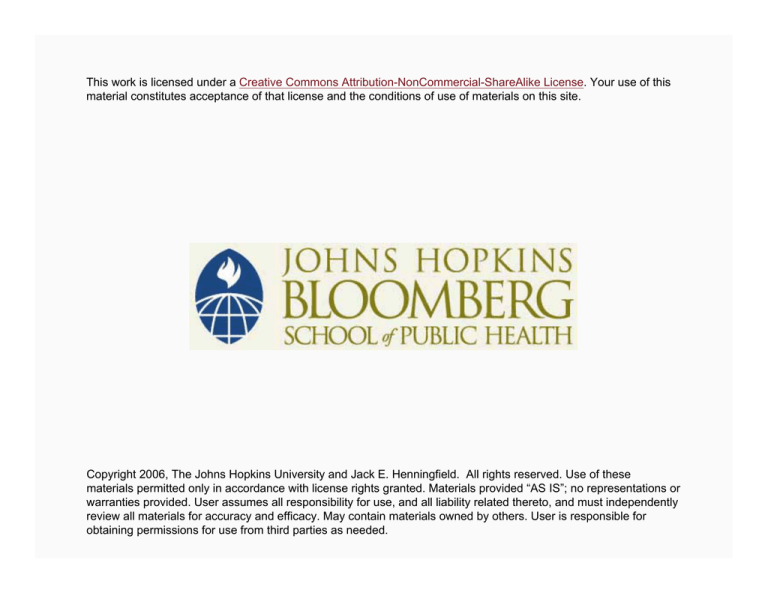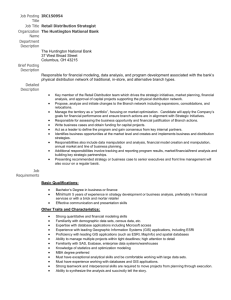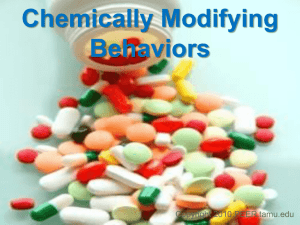
This work is licensed under a Creative Commons Attribution-NonCommercial-ShareAlike License. Your use of this
material constitutes acceptance of that license and the conditions of use of materials on this site.
Copyright 2006, The Johns Hopkins University and Jack E. Henningfield. All rights reserved. Use of these
materials permitted only in accordance with license rights granted. Materials provided “AS IS”; no representations or
warranties provided. User assumes all responsibility for use, and all liability related thereto, and must independently
review all materials for accuracy and efficacy. May contain materials owned by others. User is responsible for
obtaining permissions for use from third parties as needed.
Tobacco Addiction by Design:
Implications for Public Health and Policy
Jack E. Henningfield
Institute for Global Tobacco Control
Jack E. Henningfield
Tobacco and
addiction research
Where science
meets policy and
public health
Image source: Institute for Global Tobacco Control
3
Public Health Problem Comparisons
Tobacco vs. other disease models
− How does attempting to control tobacco
addiction compare to attempting to control
malaria?
− HIV/AIDS?
4
Section A
Introduction to Tobacco Addiction
Objectives
Discuss morbidity and mortality as side effects of
addiction and how the biology of addiction impedes
public health efforts
Describe how tobacco products are designed to
maximize addiction risk and how they have evolved
over time to appear less harmful without actually
reducing harm
Demonstrate how tobacco marketing functions to
initiate new cases and perpetuate existing cases of
addiction
6
Objectives
Evaluate how short- and long-range public health
improvement can be aided by tobacco addiction
prevention, cessation, and toxin reduction in
continuing users
Describe how the potential public health benefits of
reduced toxicity products could be negated by the
tobacco industry’s role in contributing to the initiation
and perpetuation of addiction
7
Addiction Terminology
Addiction—common term
applied to maladaptive drugseeking behavior (equivalent to
American Psychiatric
Association (APA)/World Health
Organization (WHO)
“dependence”)
Dependence—APA refers to
“nicotine” while WHO refers to
“tobacco” amount delivered to
organism
Image source: http://www.nida.nih.gov/Published_Articles/Nicotinethreat.html retrieved 2/10/06
8
Addiction Terminology
Withdrawal—transient symptoms following
abstinence when physical dependence is present (i.e.,
neuroadaptation)
Tolerance—decreased response to repeated doses
Dependence, withdrawal, and tolerance can occur
independently; withdrawal and tolerance are neither
necessary nor sufficient for dependence
9
Addiction Terminology
Abuse—maladaptive but also more
“controlled”
Abuse liability—refers to potential of a
substance to lead to abuse or dependence
due to central nervous system (CNS) effects
10
Tobacco Control Model of Nicotine Addiction
Tobacco products
Agent
Environment
social, cultural, political,
economic, and historical
factors
Host
Vector
tobacco industry;
other users
smoker/chewer
incidental host:
involuntary smoker
Source: Orleans and Slade. (1993).
11
Drug Abuse and Addiction Modulated by Diverse Factors
Drug (e.g., alcohol vs. nicotine vs. marijuana) and
formulation (e.g., smoked vs. oral vs. injection; speed
of release; sensory)
Biological factors, including genetic, physiological,
toxicological, and behavioral
12
Drug Abuse and Addiction Modulated by Diverse Factors
Social factors, including cultural and ethnic;
assumptions of normative behavior and perception
of harm
Environmental factors, including drug marketing
(licit and illicit), music, media, access, and cost
13
Drug Effects
Addictive drugs are diverse
Each produces a different
profile of effects—e.g.,
alcohol is very intoxicating,
opioids are soporific, and
cocaine is stimulating
Image source: http://www.drugabuse.gov/NIDA_Notes/NNVol12N2/NIDASupport.html accessed 2/10/06
14
Drug Effects
Key effects separate them from non-addictive drugs—
psychoactive AND reinforcer for animals and humans,
AND (usually) tolerance and withdrawal
Addiction risk also varies widely
15
The Cocaine “Epidemic”
DSM (Diagnostic and Statistical Manual of Mental
Disorders) III (1980), which first listed “tobacco
dependence” did not list cocaine dependence
Cocaine considered by many leading experts not to
meet criteria for dependence/addiction
Continued
16
The Cocaine “Epidemic”
By DSM IIIR (1987), cocaine considered number one
drug addiction problem
− What happened?
− Did molecule change or was there a genetic
transformation?
Availability, cost, social hype
Cocaine got even more like cigarettes when crack
discovered and “marketed”—unit doses conveniently
packaged and smokable
17
Conventional Tobacco Products
1.
2.
3.
4.
Photo by Dan Smith.
Image sources: 1 & 2: http://www.cr.nps.gov/museum/exhibits/gettex/tobac2.htm
3: http://www.genome.gov/17015035, 4: http://en.wikipedia.org/wiki/Cigar; retrieved 2/10/06
18
Extraordinary Product Diversity Beginning in the 1980s
Image source: http://dccps.nci.nih.gov/tcrb/stfact_sheet_combined10-23-02.pdf retrieved 2/10/06
19
Eclipse (R.J. Reynolds) 1990s
20
Ariva Cigaletts “Medical” Packaging
Image source: http://dccps.nci.nih.gov/tcrb/stfact_sheet_combined10-23-02.pdf retrieved 2/10/06
21
Projected Mortality Patterns
Source: Henningfield, J.E., Slade, J. Food and Drug Law Journal. 1998:53.
22
Tobacco-Related Deaths
Image source: National Institutes of Health
23
Side Effects
Image source: National Institutes of Health
24
Smoking Camels
Image source: National Institutes of Health
25
Tobacco-Related Deaths
Image source: National Institutes of Health
26
Tobacco-Related Deaths
Image source: National Institutes of Health
27
Smoking and Pregnancy
Image source: National Institutes of Health
28
Smoking and Pregnancy
Image source: National Institutes of Health
29
Smoking and Pregnancy
Image source: National Institutes of Health
30
1988 Surgeon General’s Report: Nicotine Addiction
Cigarettes and other forms of tobacco are addictive
Nicotine is the drug in tobacco that causes addiction
Pharmacologic and behavioral processes that
determine tobacco addiction are similar to those that
determine addiction to drugs such as heroin and
cocaine
31
FDA Tobacco Rule (1996)
Nicotine in cigarettes and smokeless tobacco is a
drug
Cigarettes and smokeless tobacco products are
drug delivery devices
Supported by pharmacology and secret documents
from manufacturers
32
Yeaman of B&W (1963)
“Moreover, nicotine is addictive. We are,
then, in the business of selling nicotine, an
addictive drug . . .”
−
Addison Yeaman (1963)—Vice President and
General Counsel of Brown and Williamson, a
subsidiary of British American Tobacco
33
Dunn of Philip Morris (1969)
“I would be more cautious in using the pharmicmedical model—do we really want to tout
cigarette smoking as a drug? It is, of course, but
there are dangerous FDA implications to having
such conceptualization go beyond these walls.”
34
Up in Tobacco Smoke
A cigarette contains about 10 mg nicotine [no tar or
carbon monoxide (CO)]
− Bioavailability—10–40%; typical dose is 1–2 mg
per cigarette
− Bioavailability manipulated by ingredients, particle
size engineering, and many other techniques
Tar or TPM—nicotine, water, and gas—not in tobacco
(pyrolysis product); CO is a pyrolysis product
35
Effects of Nicotine—Beyond Chemical Structure
Nicotine chemical structure
Amount or dose
Speed of delivery
− pKa = 8.0
Sensory factors
Other substances
36
Tobacco-Delivered Nicotine
Cigarettes
− Most toxic
− Most addictive
− Explosively fast delivery
− Optimal particle size
− pH controlled
− Sensory “optimization”
37
Tobacco-Delivered Nicotine
Chemical cocktail
− Ammonia increase dose and speed
− Acetaldehyde synergy
− Monoamine Oxidase (MAO) inhibiting
effects
− Additives reduce barriers
38
Bang
Image source: National Institutes of Health
39
Dunn of Philip Morris (1972)
“No one has ever become a cigarette
smoker by smoking cigarettes without
nicotine.”
40
British American Tobacco (1966)
“It would appear that the increased smoker
response is associated with nicotine reaching
the brain more quickly . . .”
41
Johnson of B&W (1989)
“AT [ammonia technology] is the key to
competing in smoke quality with Philip
Morris (PM) world-wide.”
42
Liggett (1971)
“Increasing the pH of a medium in which nicotine is
delivered increases the physiological effect of the
nicotine by increasing the ratio of free base to acid
salt form, the free base form being more readily
transported across physiological membranes.”
43
Manipulating Nicotine in Cigarettes
Nicotine content—tobacco type, plant part, addition
Bioavailable nicotine (content, particle size, pH,
temperature, moisture)
Cheat FTC/ISO tests with vents, burn accelerants, filter
overwrap
Alter nicotine sensory impact by masking or
unmasking
Alter nicotine effects by altering speed of absorption
(e.g., ammonia and other pH manipulations)
Alter “nicotine” effects by synergy with other
chemicals such as acetaldehyde and precursor sugars
44
Plasma Concentration after Smoking
Data source: Henningfield JE, London ED, Benowitz NL. 1990. Arterial-venous differences in plasma
concentrations of nicotine after cigarette smoking. JAMA 263(15):2049-50.
45
Section B
Neurobiology of Nicotine
Neurobiology of Nicotine
Like other abused drugs, nicotine stimulates reward
pathways in the brain and increases dopamine in the
nucleus accumbens
Effects in the brain reinforce behavior, alter mood, and
create a need that did not exist prior to drug exposure
47
Most Nicotine Stays in the Body
Image source: National Institutes of Health
48
Blood Levels of Nicotine in Body
Image source: National Institutes of Health
49
Nicotine Compensation
Compensation to reduced nicotine often assumed
Actual data and industry documents indicate wide
range of observed level and extent of compensation
and determining conditions
Dose weaning strategies can be used to enable lasting
reduction and cessation, in part by specific strategies
to minimize compensation
50
Nicotine Compensation
Could cigarettes be designed and accompanied by
instructions and education to minimize
compensation?
Could cigarettes be designed to minimize adverse
impact of compensation?
51
The Brain of a Smoker
Image source: National Institutes of Health
52
Effects of Four Drugs on Dopamine Levels
53
Brain Receptors
Image source: National Institutes of Health
54
Increased Number of Brain Receptors
Image source: National Institutes of Health
55
Hungry Brain Receptors
Image source: National Institutes of Health
56
Brain of Nonsmoker vs. Brain of Smoker
Autopsy studies revealed up to 400% more nicotine
binding sites in recently deceased smokers
compared to nonsmokers—reversibility of such
effects of nicotine exposure is uncertain
Source: Perry, D.C., M.I. Davila-Garcia, A. Stockmeier and K.J. Kellar. 1999. Increased Nicotinic Receptors
in Brains from Smokers: Membrane Binding and Autoradiography Studies. JPET 289:1545–1552.
57
Nicotine Withdrawal and Dysfunction of the Brain
Nicotine withdrawal is associated
with dysfunction of the brain and
performance—but it can be treated
58
How Long to Recovery? Are All Brain Changes Reversible?
Up to 400% increased receptors observed in some
brain regions
Tolerance can persist for a long time
Sensitivity to craving-inducing smoke stimuli can
persist for a long time
Gradual reduction of nicotine and time to learn to live
without nicotine is important for many people
Continued
59
How Long to Recovery? Are All Brain Changes Reversible?
Wide variation in effects, recovery, and capacity to
compensate
What is normal for an adult nicotine- “treated” brain
that was changed during its development and
exposed to decades of nicotine exposure?
Will some need nicotine maintenance to sustain
tobacco abstinence?
60
Addiction Risk in Ever Users
35
31.9
30
23.1
25
% 20
15.4
16.7
15
10
5
0
Alcohol Cocaine Heroin Tobacco
Source: Anthony JC, Warner LA, Kessler RC (1994), Comparative epidemiology of dependence on tobacco, alcohol, controlled
substances, and inhalants: basic findings from the National Comorbidity Survey. Experimental and Clinical Psychopharmacology
2(3):244-268.
61
Other Effects Contribute to Tobacco Use
Reduces anxiety and relieves stress and boredom
Improves performance or at least reverses withdrawal
deficits
Decreases appetite
Helps start car and answer phone?
62
Marketing Cigarettes
Image source: http://memory.loc.gov/ammem/awhhtml/awgc1/periodicals.html retrieved 2/9/06
63
Relapse
Can be triggered by events such as . . .
− Stress
− Low doses of drugs of abuse
− Drug-associated stimuli
X Note that 10 puffs per cigarette x 20 cigarettes
per day x 14 years > 1 million puffs
− Advertising and marketing
X 50 million other smokers provide ubiquitous
smoking cues
64
Marketing Cigarettes
Image source: http://cancercontrol.cancer.gov/tcrb/monographs/5/m5_foreword.pdf retrieved 2/14/06
65
Marketing Cigarettes
Image source: http://cancercontrol.cancer.gov/tcrb/monographs/5/m5_foreword.pdf retrieved 2/14/06
66
Marketing Cigarettes
Image source: http://www.cdc.gov/tobacco/sgr/sgr4kids/adbust.htm retrieved 2/14/06
67
Marketing Cigarettes
Image source: http://cancercontrol.cancer.gov/tcrb/monographs/13/m13_7.pdf retrieved 2/14/06
68
An Antismoking Ad
Image source: California Department of Health Services
69
Brown and Williamson (1979)
Low tar cigarettes—
− “Provide smokers with a choice and a
reason not to quit.”
70
Tobacco Product Claims
“Low tar,” “reduced,” “lowest,” “light,” “natural,” “no
additives”
−
These terms are regulated for other consumer
products, including beer and potato chips
−
They communicate reduced exposure
−
They imply health benefits, and they SELL
71
1970s: Bluntly Stated Claims
Image source: http://cancercontrol.cancer.gov/tcrb/monographs/13/m13_7.pdf retrieved 2/14/06
72
21st Century Claims
“Claims” in the 21st century are more subtle
due to consumer “education,” but are no less
effective than the blunt claims of the 1970s
73
Easily Covered Vents Provide Ventilation for the FTC
Vents provide
ventilation for the
Federal Trade
Commission but
are easily covered
by smokers
“Lighter” cigarettes
are more ventilated
and thus enable
compensatory
smoking
Image source: http://www.nysmokefree.com/newweb/pageview.aspx?p=4040 retrieved 2/15/06
74
FTC Rating System Options: A Misleading Marketing Tool
What should be done?
− Ban all labels implying health benefit
− Label nicotine—high, moderate, low, none
Continued
75
FTC Rating System Options: A Misleading Marketing Tool
What should be done?
−
Require labels to show how to reduce intake
X Smoke fewer cigarettes
X Take fewer puffs
X Leave longer butts
X Check butts for stain size and darkness
76
Knowing the Science of Tobacco Addiction
Knowing the science of tobacco addiction is as
useful for stopping the spread of the disease as
knowing how mosquitoes carry and spread
malaria has been vital to its control . . .
77
Fighting Tobacco Addiction
Just as knowing how mosquitoes carry and spread
malaria has been vital to its control . . .
−
−
−
The science of nicotine is vital to controlling the
tobacco epidemic
Preventing and treating tobacco dependence is
like preventing and treating malaria in a mosquitoinfested swamp
Or cocaine dependence in a crack-infested
neighborhood
78
Spheres of Influence Making Treatment Fit
Radio
Radio
Peers
Peers
Partners
Partners
Law
Law
enforcement
enforcement
Community
Media
Home
School
Teachers
Teachers
Siblings
Siblings
treatment
Coaches/
Coaches/
sponsors
sponsors
Curriculum/
Curriculum/
programs
programs
School
School climate
climate
Civic
Civic
leaders
leaders
Movies
Movies
Youth
Youth
programs
programs
Values
Values
Businesses
Businesses
Newspapers/
Newspapers/
magazines
magazines
Churches
Churches
Source: Modified from Pentz, M. A. University of Southern California.
79
Tobacco Dependence Facts to Consider
Dependence usually develops in adolescence
Most smokers are dependent
In U.S. two-thirds of youth try tobacco and one-third
to one-half “graduate”
Tobacco dependence is more than nicotine—tobacco
delivered nicotine (TDN)
All forms of nicotine are not equally interchangeable
Continued
80
Tobacco Dependence Facts to Consider
Diversity in needs and “benefits”—weight, cognition,
mood, withdrawal relief, social “tool,” coupons
20 cigarettes per day = 200 puffs (i.e., 200 “doses” per
day)
Urge surge easily leads to relapse
Relatively little “aging” related cessation
Population diversity—gender, ethnic, geographic
Ubiquitous marketing and availability of tobacco
81
Pharmacological Treatment for Tobacco Dependence
Gum and lozenge—two and four mg (deliver one and
two mg)
Nasal spray—one mg/two squirts
Oral inhaler—about 0.01 mg/puff
Patch—0.9 mg per hour for 16 or 24 hours
Bupropion—150–300 mg/day
82
Blood Levels of Nicotine by Delivery Method
Data source: Henningfield, J.E. 1995. Nicotine medications for smoking cessation. New England
Journal of Medicine 333: 1196-203.
83
Fighting Biology (Addiction)
Nicotine exposed brain finds reasons not to quit and
reasons to fear treatment
Nicotine exposed brain likes fast nicotine hits—not
slow safe nicotine
Nicotine exposed brain may never allow the person to
feel right or function right without nicotine
Medications make it possible, not easy, to quit
smoking
84
FDA Dual Strategy—1996
Prevention—1996 Tobacco Rule
− Reduce access—restrictions on sales
− Reduce appeal—restrictions on advertising and
other marketing approaches
− Treatment—over-the-counter gum and patch
available in 1996
− Increase access
− Increase appeal by highly regulated marketing
2000
− Supreme court ruled against FDA authority
− FDA does not have the authority; Congress does
85
What We Covered
Tobacco from addiction to the FDA’s attempt to
regulate it
Nicotine is the addictive drug in tobacco
But tobacco addiction involves more that just nicotine
The tobacco industry has engineered products to
increase addictiveness
Marketing helps spread tobacco addiction
86







